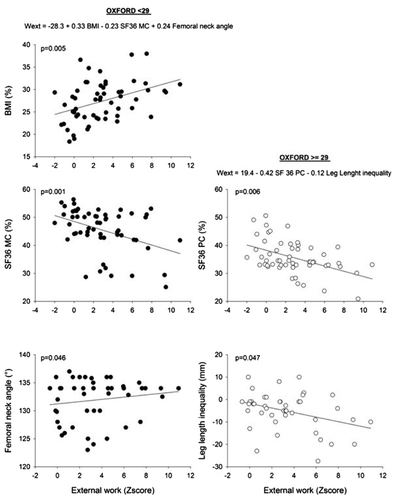1. Introduction
Osteoarthritis (OA) is the most common degenerative joint disorder in the elderly, becoming a major public health problem. In Europe, more than 20% of the population older than 60 years live with disability attributed to osteoarthritis (Eumusc project Citation2015). Hip OA is characterized by severe musculoskeletal pain and limitation of articular movement gradually decreasing autonomy and quality of life of these patients. For example, the gait is illustrated by abnormal gait patterns associated with a reduced walking speed, a reduction of the hip muscle strength, and higher energetical costs relative to asymptomatic adults (e.g. Eitzen et al. Citation2012; Foucher et al. Citation2012; Schmitt et al. Citation2015). Quantitative and exhaustive functional assessment of these patients, according to the International Classification of Functioning, Disability and Health (ICF), therefore proves to be necessary as recommended by the World Health Organization. To our knowledge, only few studies (Hampson et al. Citation1994; Botha-Scheepers et al. Citation2006) have adopted this overall approach to investigate the repercussion of hip OA on activity limitation and restriction of participation in daily life. However, these studies are based only on qualitative assessment. Therefore, the purpose of this study was to investigate and highlight the interest of a quantitative functional assessment based on the ICF model as reference framework in order to measure and quantify disability in patients with severe hip OA. We hypothesized that more great is alteration of gait mechanism worst are clinical scores and more severe restriction of participation.
2. Methods
2.1. Patients
60 patients (aged 46–87 years old, mean ± SD: weight 75 kg ± 1.7, height 1.68 m ± 0.08, BMI 28% ± 1.6) were diagnosed as having severe hip OA (grade IV - end-stage) namely classified as severe hip OA which were scheduled for a total hip arthroplasty.
2.2. Outcome measurements
All patients were assessed based on the ICF model. Assessment of body structure and function included a standard radiological evaluation and the Oxford Hip Score (OHS) questionnaire. The gait analysis, measuring the activity domain, was based on mechanical muscular work (computed from treadmill platforms and motion capture system) and energetic cost. The patients walked at self-speed (2.5 km/h ± 0.5) on a treadmill. A motion capture system of eight infrared cameras (Elite, BTS) measured, at 200 Hz, the 3D coordinates of 19 reflective markers located according to Davis model. The SF-36 allowed to assess restriction of participation.
2.3. Statistical analyses
We used a principal component analysis (PCA) in order to obtain a relationship between ICF domains. Based on the results of PCA, a multivariate analysis (backward stepwise regression) was carried out to underline the impact of different ICF domains on gait activity.
3. Results and discussion
The RX values and OHS are affected. The SF-36 PC and MC are inferior to 50%. More particularly, the observed results corresponding to the impact of hip OA on locomotor mechanism shows an alteration of the total muscular mechanical work (calculated as the sum of external work and internal work) due to a significantly increase of external work (computed from the ground reaction forces) as compared to healthy subjects. However, neither the internal work (computed from kinematic data) nor the overall energy cost were affected. Therefore, only the excessive external work variable has been taken into consideration for analyses. The PCA has highlighted the correlations between the external work variable and the function and participation domains. These correlations allowed to distinguish two groups of patients: ‘very painful’ (OHS < 29) corresponding to 70% of our sample vs ‘moderately painful’ (OHS ≥ 29) corresponding to 30% of our sample. Finally, a multivariate analysis allowed to identify the independent variables affecting more specifically the gait mechanisms in each group (Figure ).
In other words, our results show that a patient (OHS < 29) with a high BMI and an important neck femoral angle will presents a more important alteration of gait. It is then advisable to contact a physician for a consult with an Orthopaedic Surgeon. For the patient (OHS ≥ 29) with a mechanical discomfort which is reflected in an alteration of the work, it is advisable, in a first phase, to benefit from non-surgical treatment, such as exercise, weight loss, and/or anti-inflammatory medication, etc.
4. Conclusions
This study shows the importance of analyzing the interactions between the different ICF domains in patients with severe hip OA and more particularly the impact of OA on their whole quality of life. The biomechanical analysis of gait provides objective evidence of the altered mechanism of locomotion in patients with severe hip osteoarthritis. These measurements may be relevant to assess impairment in ambulatory patients and may be also useful in clinical research to improve knowledge of the effect of treatment. The quantitative functional evaluation is therefore an interesting tool to better guide the treatment of patient.
References
- Botha-Scheepers S, Riyazi N, Kroon HM, Scharloo M, Houwing-Duistermaat JJ, Slagboom E, et al. 2006. Activity limitations in the lower extremities in patients with osteoarthritis: the modifying effects of illness perceptions and mental health. Osteoarthr Cartil. 14:1104–1110.10.1016/j.joca.2006.04.011
- Eitzen I, Fernandes L, Nordsletten L, Risberg MA. 2012. Sagittal plane gait characteristics in hip osteoarthritis patients with mild to moderate symptoms: a cross-sectional study. BMC Musculoskelet Disord. 13:258–261.10.1186/1471-2474-13-258
- Eumusc project. 2015. Musculoskeletal health status in Europe. http://www.eumusc.net.
- Foucher KC, Schlink BR, Shakoor N, Wimmer MA. 2012. Sagittal plane hip motion reversals during walking are associated with disease severity and poorer function in subjects with hip osteoarthritis. J Biomech. 45:1360–1365.10.1016/j.jbiomech.2012.03.008
- Hampson SE, Glasgow RE, Zeiss A. 1994. Personal models of osteoarthritis and their relation to self-management and quality of life. J Behav Med. 17:143–158.10.1007/BF01858102
- Schmitt D, Vap A, Queen RM. 2015. Effect of end-stage hip, knee, and ankle osteoarthritis on walking mechanics. Gait Posture. 42:373–379.10.1016/j.gaitpost.2015.07.005

